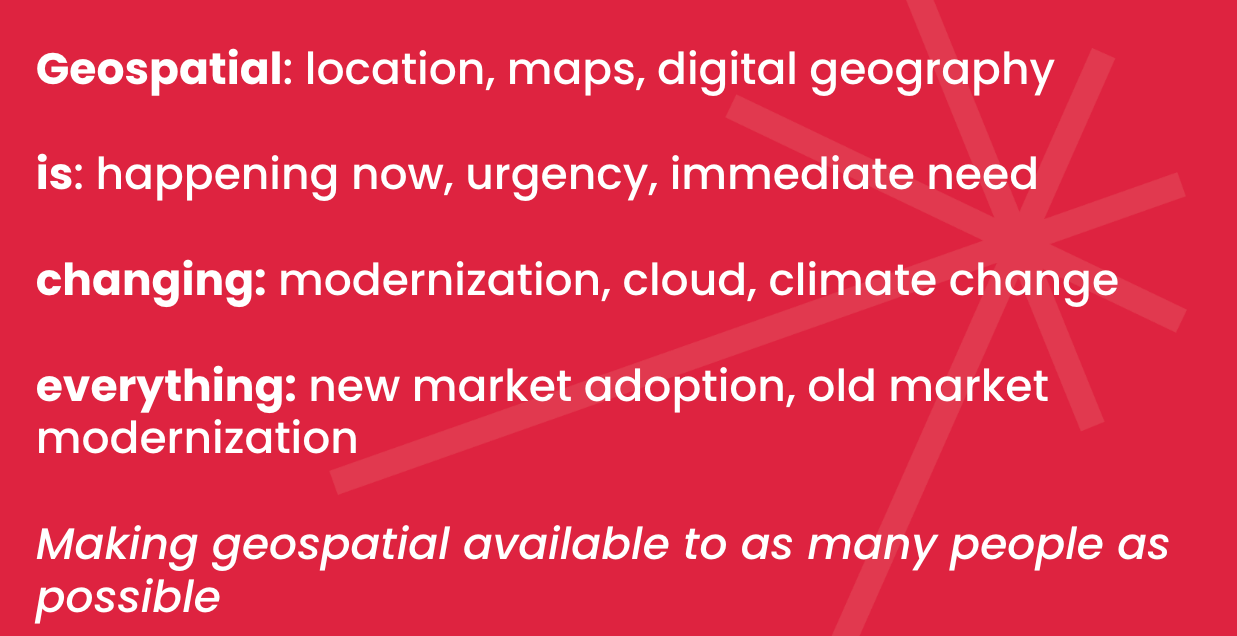Geospatial is changing everything
Refinding why
Our proximity to geospatial technology shifted in the first quarter of this century, and that proximity will incrementally become more intimate. Geospatial technology is literally changing the way every business and organization operates. Interestingly, this is happening largely undetected by the traditional Geographic Information Systems (GIS) sector.
There was a time when I would devour all sorts of business books. I would write notes and try to learn new and deep thoughts. Some were good; some were just asinine. I came to the conclusion that there is a certain genre of business book that should really be a long-form blog post. Beyond a thousand useful words worth considering, the rest is generally just repetition and success bias. Of course, there is a limited business model attached to blog posts, so I get it. Simon Sinek is one of those authors I’ve avoided because the concepts seem so annoyingly obvious.
Every company needs a why. But for some time, I have struggled with this most basic of ideas. I have always known we did have a why, but I found its articulation incredibly difficult. I could always tell when a project was interesting and fitted Sparkgeo, and I had some pretty good instincts for when bad fits were proposed. But being able to define one from the other was hard.
At Sparkgeo, we do many different things for many different organizations. In the context of "finding focus," this wide disparity of projects was a little embarrassing. At first blush, in finding focus, we seemed to be anything but.
In re-listening to Simon Sinek's book “Start with Why.” The annoyingly obvious concept was doubly so because the solution seemed elusive. It occurred to me to have a backward cast of the things we have done to find the patterns. I started reflecting on a video we made a few years ago that still resonates today. "Geospatial is Changing Everything." The more I thought this through, the more I realized that this is the best definition of our why I have yet to come across.
To back up, a little Sinek is not the only person to identify that having a strategic overarching purpose is valuable, but his book is a succinct argument for driving an organization through its "why." Whilst I typically find this kind of literature cheesy, I can't fault the logic of driving purpose into a team, and the simplicity of his framework is enormously attractive. In fact, I have talked about organizational North Stars and strategy for years, but linking these to a single statement you might print on a teeshirt is hard.
I listen to most books while I'm running. This is a great way of combining a few essentials: mental health, growth, and fitness. But this process also allows a kind of meditative state and some space for timely reflection on the words being vibrated into my consciousness. In this case, I was able to see that almost everything Sparkgeo has done has been about delivering geospatial in a changing business or organizational environment. We have always been about modernization or new markets. This is why when we look inside more traditional geospatial teams, we find ourselves so underwhelmed.
This is also why I use William Gibson's quote so much (again, thanks to Marc Ventresca for raising my awareness of it.) Gibson understands that the notion of the future or change is relative to the individual, not the date. Things are always changing around us, and within our context, geospatial technology will continue to change the human experience, hopefully for the better.
So, geospatial is changing everything, has become our why, mainly because it always has been.
This is not an excuse to find a convenient why that fits a hodge-podge of services work, but instead an articulation of the hidden focus we have always had but didn't know it. Because when I dig into the words, the resonance only grows.
On every level, these words are a combination of our values and attitudes. I think we might have just found our superpower.



